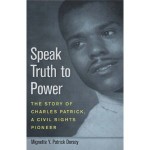    In any downtown, sometimes getting a parking space is a hassle. So having someone cut into the space you have been waiting for can become a big deal. But in Birmingham, Alabama in 1954, that small event became so big a deal that it set off a struggle for civil rights and racial change.
   In any downtown, sometimes getting a parking space is a hassle. So having someone cut into the space you have been waiting for can become a big deal. But in Birmingham, Alabama in 1954, that small event became so big a deal that it set off a struggle for civil rights and racial change.
   Charles Patrick, a black man, a resident of Birmingham was downtown to buy his adopted son a Boy Scout uniform. He had been searching for a parking space for a while and just as he went past one he saw a man about to pull out. Mr. Patrick stopped and waited for the man to pull out so that he could back into that space. The man pulled out and immediately a white woman pulled into that very space. Mr. Patrick got out of his car walked over to the woman’s car and the two had this interaction.
   “’Ma’am, I was waiting. The man was pulling out and I was backing in.’ [Mr. Patrick] said the woman yelled back, ‘I’m getting this spot. My husband is a police officer.’’…He doesn’t own the streets of Birmingham,’ [Mr. Patrick] recalled telling her.â€
   Mr. Patrick returned to his car, drove off, found a parking space, conducted his business downtown and then went home. That evening two policemen came to his house and arrested him. That evening, while in jail, two other policemen, both white, one of whom was the husband of the white woman in the car, came in and beat Mr. Patrick with their fists and when he fell to the floor kicked him over and over again.
   From there the story takes unexpected turns.  Birmingham, Alabama in the 1950s, a black man was beaten by the police. No surprise. But that black man goes to court to press charges and to tell of being beaten… huh? There was court hearing and lots of news coverage because what was happening was unusual.
   At the hearing, the judge ruled to suspend the two police officers. Days later, city commissioners met to render judgment about what to do about all this and ruled to reinstate the two police officers. That decision brought outraged response from the white community in the form of letters to the editor of the “white†newspapers.Â
   What year you ask? 1954. Where again? Birmingham, Alabama. Really, you wonder.
    That is what makes this story important. The writer is the journalist daughter of Charles Patrick. Ms. Dorsey has tracked down every news article, editorial and letter to the editor written about this event in her father’s life and in the history of the civil rights movement. Yes, she is telling this story because it happened to her father, but also because what she found surprised her:
   “The editorials and letters I read in support of my father changed my views about Birmingham. Growing up in Los Angeles… I had… adopted beliefs that white Americans in the South would forever harbor animus toward African Americans, that white citizens applauded and embraced violence against blacks, and that white citizens in the South would never change. But after reading the letters written in response to my father’s case, I realized that Birmingham was a mixture of nobility and treachery like any other city.â€
   Yeah… but it was still Birmingham, Alabama wasn’t it. How could it be that whites would come to support a black man in Bull Connor’s city? Well, it turns out it wasn’t the Bull’s city at that time because Mr. Connor had not run for reelection because of an embarrassing controversy involving his infidelity. Later he would return to power, but Ms. Dorsey writes:
   “With former Police Commissioner Eugene ‘Bull’ Connor out, it was…a four-year period when moderate, racially progressive powers spoke, however cautiously.â€
   With that window of opportunity, through many steps and the help of black and white hands, her father won his court case, with the two officers being fired. Told with clear, sturdy, sometimes affecting prose, this compelling story and warm family history makes for a captivating read. Working from many sources, but especially her own interviews and conversations with her father, Ms. Dorsey tells this story with humor, anger, puzzlement, affection and new insights into the context of the event and the complexity of the civil rights struggle. Her new insights include:
   “Charles Patrick’s story is part of the civil rights story. His courageous actions laid a foundation for the movement, and dramatized for the oppressed African-Americans of Birmingham in 1954 that fortitude and truth in the face of power can prevail…Yet before any movement where people march en masse for basic civil rights denied, there are fuzzy accounts of individual courage, the details of which are often buried safely within the memories of the participants themselves.â€
   That is why this is an important book. It brings to life an important yet mostly unknown, seemingly small story from the civil rights struggle. We have heard the big stories. Now is the time for the small stories to be told.


April 6th, 2011 at 10:41 PM
Read it! A good read.
April 11th, 2011 at 12:08 AM
Hey, excellent web site. I really discovered this upon Msn, and i am pleased I did. I’ll definately be coming back right here more regularly. Wish I possibly could increase the conversation and bring a little more to the table, however ‘m just taking in just as much info as I will at the moment. Thanks
April 28th, 2011 at 6:37 PM
Looking forward to reading more. Great article.Thanks Again. Cool.